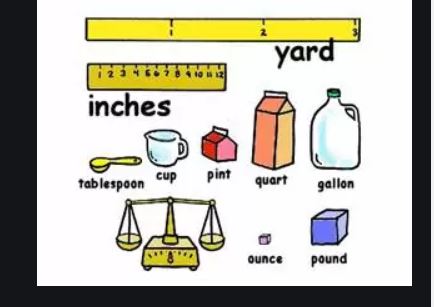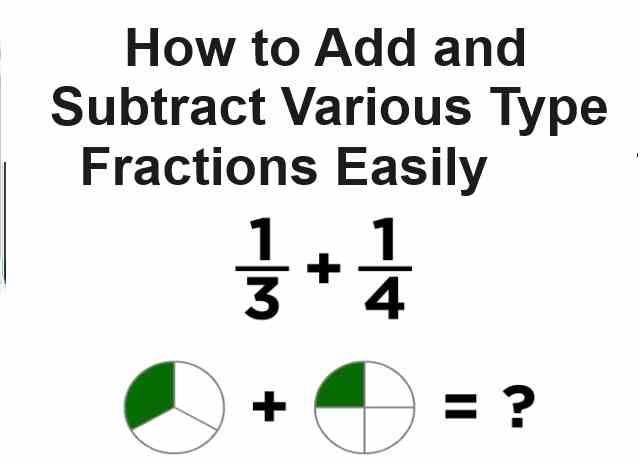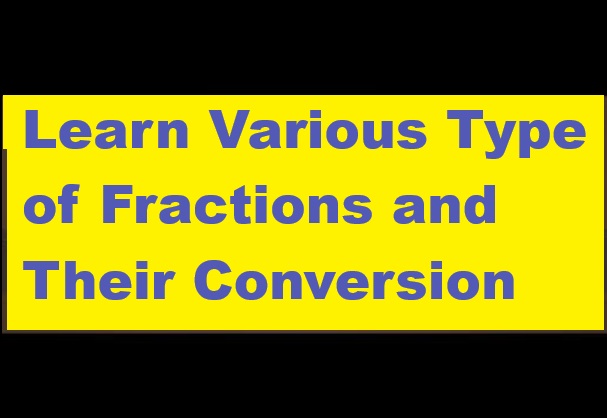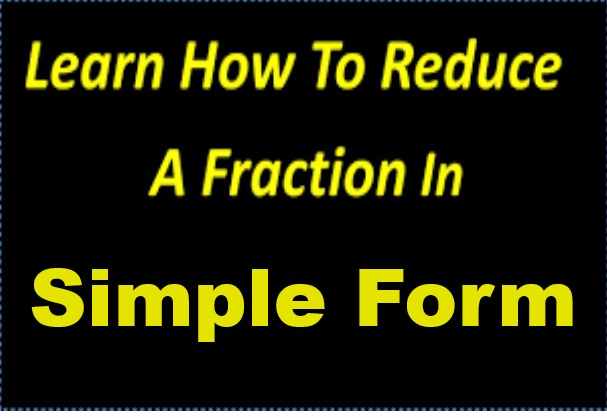Physical Quantities and Measurement ICSE Class-6th Concise Selina Physics Solutions Chapter-2. We Provide Step by Step Answer of Objective, True False , Fill in the blanks, Match the following , Short / Long Answer Type , Numericals of Exercise-2 Physical Quantities and Measurement ICSE . Visit official Website CISCE for detail information about ICSE Board Class-6.
Physical Quantities and Measurement ICSE Class-6th Concise Selina Physics Solutions Chapter-2
A. Objective Questions
1. Write true or false for each statement
(a) S.I. unit of temperature is fahrenheit.
Answer. False
(b) Every measurement involves two things – a number and a unit
Answer. True
(c) Mass is the measure of quantity of matter.
Answer. True
(d) The S.I. unit of time is hour.
Answer. False
(e) The area can be expressed as the product of length of two sides.
Answer. Tme
2. Fill in the blanks
(a) The S.I. unit of length is …. of time is …. of mass is ….
(b) °C is the unit of ….
(c) 1 metric tonne = …..
(d) The zero mark in Celsius thermometer is the melting point of …
(e) The thermometer used to measure the human body temperature is called the ….thermometer.
(f) The normal temperature of human body is …. °C or …. °F.
(g) The ….of an object is measured with the help of a beam balance.
Answer
(a) The S.I. unit of length is metre of time is second of mass is kilogram.
(b) °C is the unit of temperature.
(c) 1 metric tonne = 1000 kg
(d) The zero mark in Celsius thermometer is the melting point of ice
(e) The thermometer used to measure the human body temperature is called the clinical thermometer.
(f) The normal temperature of human body is 37 °C or 98.6 °F.
(g) The mass of an object is measured with the help of a beam balance.
3. Match the following columns Physical Quantities and Measurement

4. Select the correct alternative
(a) The symbol of degree celsius is
- 1 C°
- °F
- K
- °K
Answer
1 C°
(b) lO mm is equal to
- 1 cm
- 1 m
- 10 dm
- 10 cm
Answer
1 cm
(c) The amount of surface occupied by an object is called its:
- volume
- area
- mass
- length
Answer
area
(d) A metre ruler is graduated in:
- m
- cm
- mm
- km
Answer
°C
(e) A thermometre is graduated in:
- kelvin
- °C
- g
- cm
Answer
°C
B. Short/Long Answer Questions of Physical Quantities and Measurement
Question 1.
What is measurement ? How is a measurement expressed ?
Answer:
Measurement is a comparison of an unknown quantity with a known fixed quantity of the same kind.
The value obtained on measuring a quantity is called its magnitude. The magnitude of a quantity is expressed as numbers in its unit.
Question 2.
State two characteristics of a unit.
Answer:
Two characteristics of a unit are
- It should be of convenient size.
- It must be universally accepted, i. e. its value must remain same at all places and at all times.
Question 3.
Name four basic measurements in our daily life.
Answer:
In our daily life we measure the following four basic physical quantities.
- Length
- Mass
- lime
- Temperature
Question 4.
What are the S.I. units of
- mass
- length
- time and
- temperature. Write their names and symbols.
Answer:
S.I. units are as follows
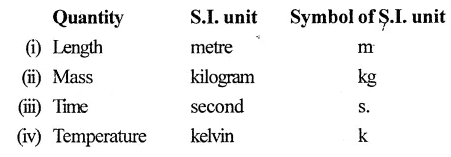
Question 5.
Define one metre, the S.I. unit of length. State its one multiple and one sub multiple.
Answer:
One metre is defined as the distance travelled by light in air in of a second
Multiple of metre = Kilometre
Submultiple of metre = Centimetre
Question 6.
Convert the following quantities as indicated
(a) 12 inch = ft
(b) 1 ft = cm
(c) 20 cm = m
(d) 4.2 m = cm
(e) 0.2 km = m
(f) 0.2 cm = mm
(g) 1 yard = m
Answer:
(a) l2 inch 1 ft
(b) 1 ft = 30.48cm
(c) lOO cm 1m
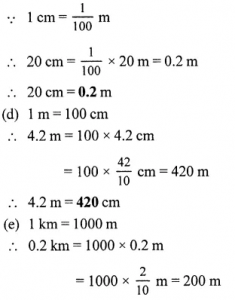
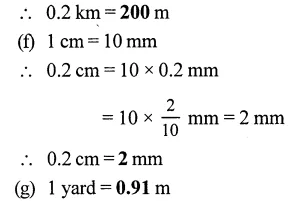
Question 7.
(a) Describe in steps how would you measure the length of a pencil using a metre rule. Draw a diagram if necessary.
Answer:
To measure the length of a pencil using a metre rule, place metre rule with its marking close to the object. Let PQ be a pencil.
The end P of the pencil coincides with the zero mark on the ruler. The end Q of the pencil is read by keeping the eye at the position ‘B’ vertically above the end Q. So the length of pencil is 4.3 cm.
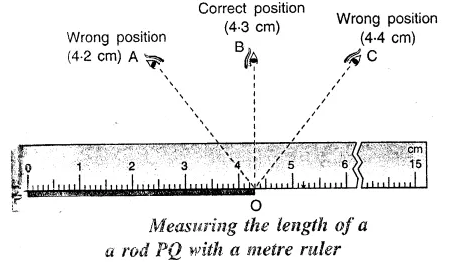
(b) Explain with an example how you will use the metre ruler in part (a) if the ends of ruler are broken.
Ans. The ends of the ruler get damaged with use and its zero mark may not be visible. To measure the length of an object with such a ruler, the object is placed close to a specific markings on the ruler and positions of both ends of the object are read on the ruler.
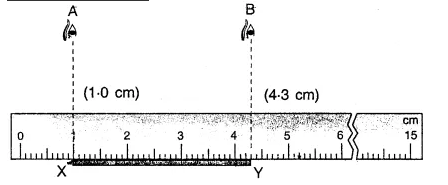
The difference of the two readings gives the length of the object. In fig. the reading on ruler at the end X is 1.0 cm and at the end Y is 4.3 cm. So the length of the rod XY is 4.3 — 1.0 = 3.3 cm.
Question 8.
Name the device which you will use to measure the perimeter of your play ground. Describe in steps how you will use it.
Answer:
We will use a measuring tape to measure the perimeter of our playground.
To measure the length of playground the tape is spread along the length of the curved area.
Question 9.
The diagram below shows a stick placed along a meter ruler. The length of the stick is measured keeping the eye at positions A, B and C.
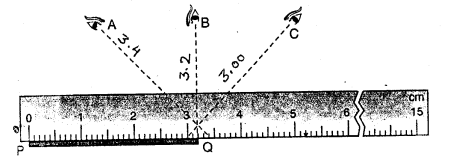
Answer:
(a) Write the length if stick PQ as observed, for each position of the eye. Are they all same?
Ans. Length of stick PQ from
Position A =3.4 cm
and Position B = 3.2cm
The Position C = 3.00 cm
No they are not same.
(b) Which is the correct position of the eye? Write the correct length of the stick.
Ans. ‘B’ is the correct position of the eye. Correct length of the stick PQ = 3.2cm
Question 10.
Define mass. State its (1) S.I. (2) C.GS and (3) EP.S. units. How are they related ?
Answer:
The mass of a body is the quantity of matter contained in it. The S.I. unit of mass is kilogram. In short form, it is written as kg.
In C.GS. system, the unit of mass is gram, (symbol g).
In F.P.S. system, the unit of mass is pound (symbol lb)
Question 11.
Convert the following quantities as indicated:
(a) 2500 kg = ………. metric tonne.
(b) 150 kg = quintal
(e) 10 lb = ………. kg
(d) 250 g = … .kg
(e) 0.01 kg = ………. g
(f) 5 mg = ………. kg
Answer:
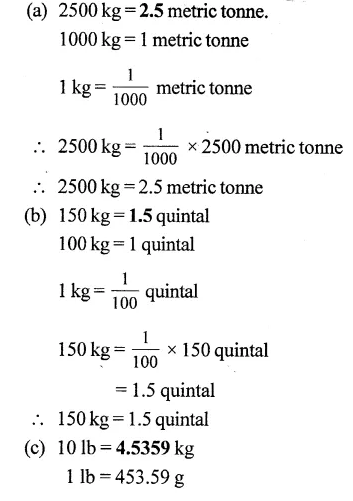
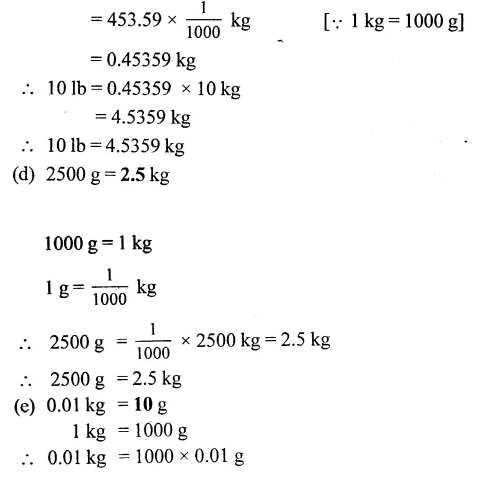
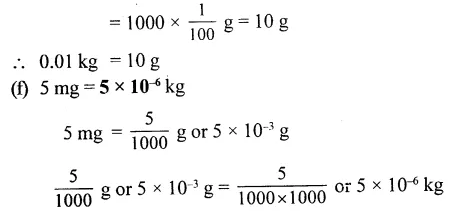
Question 12.
Name the instrument which is commonly used to measure the mass of a body. State how is it used ?
Answer:
Instrument commonly used to measure the mass of a body, is the beam balance.
When we hold up the balance, we observe that when there is nothing on either pan, the beam is horizontal. The body whose mass is to be measured is placed on the left pan. The standard weight are put on the right pan. They are so adjusted that the beam is again horizontal on holding the balance up. The total of the standard weights gives the mass of the given body.
Question 13.
Define one kilogram, the S.I. unit of mass. How is it related to (i) quintal (ii) metric tonne and (iii) gram.
Answer:
The mass of 1 litre of water at 4 °C is taken as 1 kilogram
1 quintal = 100 kg
1 metric ton = 10 quintal = 1000 kg
Question 14.
Name and define the S.I. unit of time. How is it related to (i) minute (ii) hour, (iii) day and (iv) year ?
Answer:
The S.I. unit of time is second. In short form we write it as ‘ S ’.
One second is the time interval between the two consecutive ticks that you hear from pendulum wall clock.
1 min = 60 s
and 1 h = 60 min. = 3600 s.
while 1 day = 24 h = 86400 s.
1 year = 365 days = 3.15 × 107 s.
Question 15.
Name two devices used to measure the short time interval of an event.
Answer:
Two devices used to measure the time interval of an event are
- StopWatch
- Stop Clock
Question 16.
Express in second
- 3 minute 15 second and
- 5 hour 2 minute 5 second.
Answer:
- 3 minute = 15 second
1 minute = 60 second
3 minutes 15 second = 60 × 3 + 15
= 180 + 15
= 195 seconds - 1 minute =60 second
2 minutes =2 × 600 = 120 second …(1)
1 hour 3600 second
5 hour 3600 × 5 = 18000second …(2)
5 hour 2 minutes and 5 second
= 18000 + 120 + 5 = 18125 seconds
Question 17.
What does the temperature measure ?
Answer:
Temperature measures the degree of coldness and hotness of a body.
Question 18.
Name the
- S.I. unit and
- one common unit of temperature. Write their symbols also.
Answer:
The S.I. unit of temperature is kelvin (symbol K).
Common unit of temperature is degree centigrade (symbol °C)
Question 19.
Name the instrument used for measuring of the temperature of a person. Draw its labelled neat diagram.
Answer:
The temperature is measured with a thermometer.

Question 20.
Write the temperature of (i) melting ice (ii) boiling water.
Answer:
The temperature of
- melting ice = 0 °C
- boiling water = 100 °C
Question 21.
What is a clinical thermometer ? State its special feature. Draw a labelled neat diagram of a clinical thermometer showing the range of temperature marked on it.
Answer:
Doctors use a special thermometer called the clinical thermometer for measuring the temperature of the patient’s body. This thermometer has the markings from 35°C to 42°C. It has a slight bend or kink in the stem just above the bulb. This kink is called the constriction. This constriction prevents the mercury from falling back all by itself. The temperature of a healthy person is 37°C. This temperature is marked by a red arrow.

Question 22.
What is the normal temperature of the human body ? How is it indicated in a clinical thermometer ?
Answer:
Normal temperature of a human body is 37°C or 98.6 °F.
To measure the temperature of a patient’s body, its bulb is kept either below the tongue or under the arm’s pit of the patient for about a minute. Then the thermometer is taken out and its reading is noted. When the temperature of patient’s body is above 37°C, he is said to suffer with fever.
Question 23.
Can a clinical thermometer be used to measure the temperature of the boiling water ? Give reason for your answer.
Answer:
No, a clinical thermometer cannot be used to measure the temperature of boiling water. ,
The reasons are
- It has a very small range.
- It can break on cooling and on excess heating.
Question 24.
Explain the term ‘area of a surface’.
Answer:
The total surface occupied by an object is called its area or surface area.
Question 25.
Name the S.I. unit of area and define it.
Answer:
The S.I. unit of area is square metre or meter2 which in short form is written as m2.
Question 26.
How are the units
- square yard
- hectare
- km2
- cm2
- mm2 related to the S.I. unit of area ?
Answer:
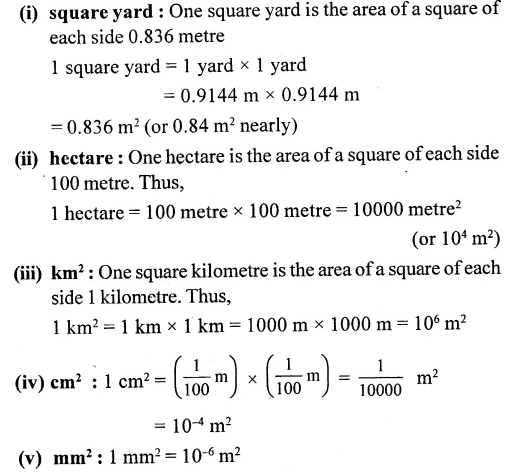
Question 27.
Explain how you will measure the area of (i) a square (b) a leaf?
Answer:
The area of a square can be calculated by using the following formula –
1. Area of square of side l
= side x side
= l × l = L2 .
The area of a leaf is obtained by using a graph paper. A graph paper has small squares of each side 1 mm. The area of each big square is 1 cm2.
Procedure: Place the leaf on graph paper. Draw its outline on the paper and remove it. Now count the number of complete squares. To this add the number of incomplete squares which are half or more than half. Ignore the squares which are less than half. Thus,
Approximate area = (No. of complete squares + no. of half or more than half of incomplete squares) × area of one square.
Return to ICSE Class-6 Concise Selina Solutions
thanks
Please, Share with your friends

